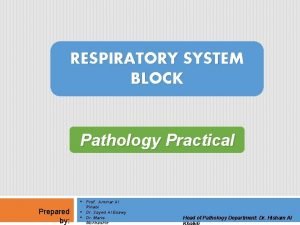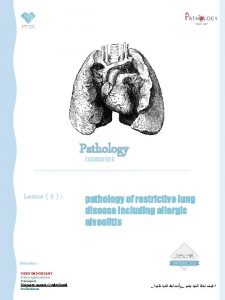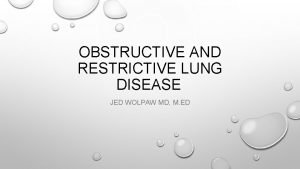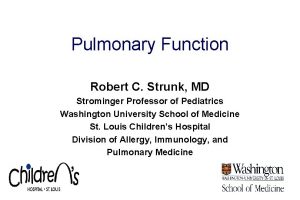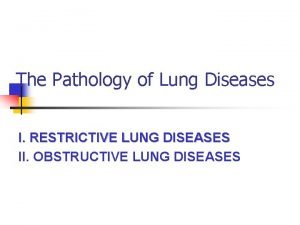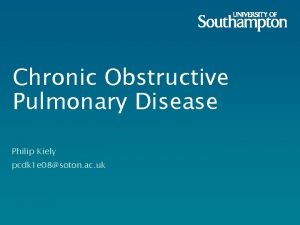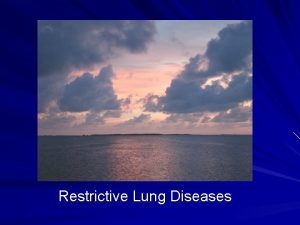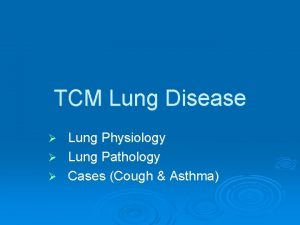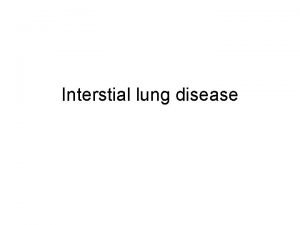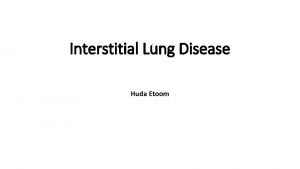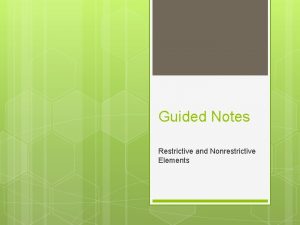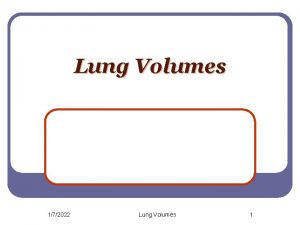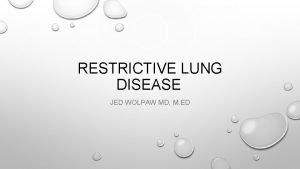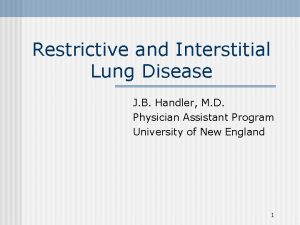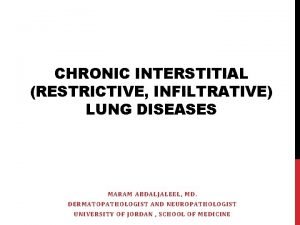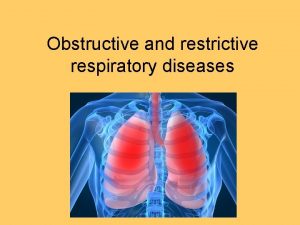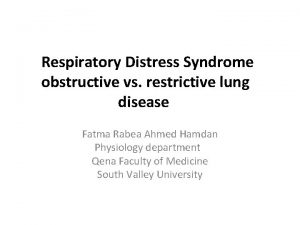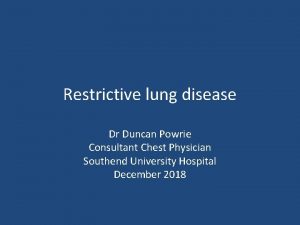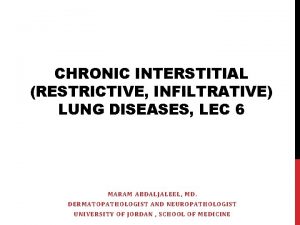Pathology teamwork Lecture 3 pathology of restrictive lung


























- Slides: 26

Pathology teamwork Lecture ( 3 ) : pathology of restrictive lung disease including allergic alveolitis Color Index : ▪VERY IMPORTANT ▪Extra explanation ▪Examples ▪Diseases names: Underlined ▪Definitions . . ﻭﺃﻨﺖ ﻟﻌﻠ ﺍﻟﻧﻴﺎ ﻃﺒﻴ؟. . * ﻛﻴﻒ ﺗﻌﻙ ﺍﻟﻧﻴﺎ ﺑﺸﻴ

Objectives : • Understand the structure and constituents of the lung interstitium as well as the restrictive changes which occur in diseases of the interstituim (ILD) • Know the symptoms of ILD: progressive breathlessness and cough • Know subtypes of ILD: acute and chronic • Discuss the causes, morphology and outcome of acute ILD • Appreciate the pathogenesis of chronic ILD regardless of their type. • Become aware of the classification of interstitial lung diseases. • Discuss examples of interstitial lung diseases including: – idiopathic pulmonary fibrosis – Pneumoconiosis – Hypersensitibity pneumonitis – Goodpasture syndrome – Sarcoidosis

Introduction : Restrictive lung diseases : are a category of diseases that restrict lung expansion resulting in a decreased lung volume so the airways are fine but the problem here is that there is something that restrict the lung such as fibrosis. But you might find a problem in the airways but in this case it's a secondary problem to the restriction. Remember that : total lung volume and forced expiratory volume in one second (FEV 1) and forced vital capacity (FVC) are reduced with normal to high FEV 1/FVC ﻗﺴﻤﺔ ﻋﺪﺩ ﺻﻐﻴﺮ ﻋﻠﻰ ﺻﻐﻴﺮ ﻳﺴﺎﻭﻱ ﻋﺪﺩ ﻛﺒﻴﺮ

RESTRICTIVE LUNG DISEASE The restrictive lung diseases are divided into: Intrinsic lung disease / disease of the lung parenchyma / primary ILD The disease cause : -inflammation -scarring of the lung tissue (ILD) -Result in filling of the air spaces with exudate and debris (pneumonitis ) They are characterized by: -Inflammatory infiltrates in the interstitial space - The interstitium becomes thickened and fibrotic (stiff lung ) Extrinsic disorders or extraparenchymal diseases The chest wall, pleura, and respiratory muscles are the components of the respiratory pump, and they need to function normally for effective ventilation. Abnormalities of the chest wall include: -bony abnormalities (kyphosis or kyphoscoliosis) -massive pleural effusion -morbid obesity -neuromuscular disease of respiratory muscles results in respiratory muscle There is decreased oxygen-diffusing capacity. ( they are acute or chronic ) weakness and respiratory failure e. g. myopathy or myositis, quadriplegia, or phrenic neuropathy from infectious or metabolic causes Guillain-Barré Syndrome: is a neurological disease , can manifest with paralysis with limbs , upper limbs or lower , sometimes effect the respiratory muscles , intercostal or diaphragm , could lead to Restrictive lung disease ﻣﺠﻤﻮﻋﺔ ﺍﻣﺮﺍﺽ ﺃﺪﺕ ﻝ ﻣﺮﺽ ﺍﻟﺮﺋﺔ ﺍﻟﻌﺎﺻﺮﺓ Constituents of the lung interstitium

INTRINSIC TYPE OF RESTRICTIVE LUNG DISEASES Characterized By : Intrinsic type of restrictive lung diseases reduced compliance of the lung. It can be : Acute or Chronic. Dyspnea Hypoxia Important sign and symptoms In advanced cases of restrictive lung disease there is severe hypoxia hypercapnia Cyanosis respiratory failure cor pulmonale. The final stage of all restrictive lung disease is extensive fibrosis with honeycomb lung. The lung becomes more stiff and solid. End stage lung disease: Honeycomb lung (both alveoli and bronchioles coalescence to form cysts lined with cuboidal or columnar epithelium and seperated by inflammatory fibrous tissue). To differentiate between all types we have to see: • Clinically features • X-ray • Grossly • Microscopic • Other laboratory tests Normal Honeycomb lung Extra explanation: -why is there "dyspnea" ? because the hallmark of this disease is reduce compliance ( more pressure is required to expand the lung because they are stiff) which in turn necessitate increased of breathing leading to dyspnea -why it causes hypoxia? Because there is damage to the alveolar epithelium and interstitial vasculature produces abnormalities in the ventilation-perfusion ratio leading to hypoxia.

Acute restrictive lung diseases (INTRINSIC TYPE) ARDS overview Adult respiratory distress syndromes Neonatal respiratory distress syndromes Adult Respiratory Distress Syndrome (ARDS) NRDS overview Very useful video • What is AEDS? ARDS is a severe acute lung injury with diffuse alveolar injury. * ﻫﻮ ﻋﺒﺎﺭﻩ ﻋﻨﺪ ﺍﻱ ﺍﻧﺠﺮﻱ ﺗﺤﺪﺙ ﻣﺜﻞ ﺍﺣﺘﺮﺍﻕ ﺍﻟﻤﻨﺰﻝ ﻭﺍﺳﺘﻨﺸﺎﻕ ﺍﻟﺪﺧﺎﻥ ﺃﻮ ﺣﺎﺩﺙ ﻣﺮﻭﺭ ﻭﺃﺜﺮ ﻋﻠﻰ ﺍﻟﺮﺋﻪ. . ﻓﺠﺄﻪ ﻟﻠﺮﺋﺘﺎﻥ ﻭﺗﺄﺜﺮ ﻋﻠﻰ • What is the other names for ARDS? shock lung / diffuse alveolar damage / adult respiratory failure/acute alveolar injury/ traumatic wet lung • What are the clinical Features of ARDS? 1. rapid acute onset progressive severe life threatening respiratory insufficiency, cyanosis, severe arterial hypoxia 2. refractory to oxygen therapy and that may progress to multi- organ failure ** 3. bilateral (both lungs) pulmonary infiltrates (edema) in the absence of evidence of left sided heart failure (because the left sided heart failure also can cause a bilateral pulmonary edema so we should make sure of absence of evidence of left sided heart failure) • What does it cause? It is the most common cause of non-cardiogenic pulmonary edema • What cause ARDS? It can be caused by many conditions such as 1. Direct lung injury (look in the next slide for more information) 2. Indirect lung injury (look in the next slide for more information) • What is the most common cause of ARDS? Pneumonia and sepsis are the most common cause *ARDS is an accumulation of fluid in the alveoli due to increase permeability of alviolar blood capillary ** wont able to exchange the oxygen since the alveoli is full of fluid and will lead to decrease Po 2 in the blood and may lead to multi- organ failure if the oxygen multi- organ failure is not enough

Pneumonia Severe acute respiratory syndrome (SARS) 1 Fat embolism Direct injury to lung Aspiration of gastric contents Pulmonary trauma 3 Near drowning The virus is a coronavirus that destroys the type II pneumocytes and causes diffuse alveolar damage 1 Irritants such as chlorine, O 2 toxicity 2 Aspiration of oropharyngeal or gastric contents into the lower respiratory tract 3 Post lung transplant Toxic inhalation injury 2 Sepsis Acute pancreat itis e. g. bone fractures, head injury, burns, radiation Cardiop ulmonar y bypass 4 e. g multiple transfusion, coagulation disorders 5 6 Transfus ion Shock indirect injury to lung such as bleomycin 7 such as heroin 8 blood Severe trauma 4 Uremia 8 in the urine Overdos e with street drugs 7 Therape -utic drugs 6 Hematol ogic conditio ns 5

Pathophysiology of ARDS Important • ARDS is associated with diffuse alveolar damage. • It is initiated by injury to: 1. alveolar capillary endothelium with a resultant increase in alveolar capillary permeability 2. alveolar epithelium • The injury is induced by : A. Neutrophils releasing substances toxic to alveolar wall. B. Activation of the coagulation cascade. C. O 2 toxicity (due to formation of free radicals). • This causes leakage of protein-rich fluid into alveoli, form alveolar hyaline membranes, line the inner surface of alveoli (the membrane is composed of fibrin and cellular debris) • The lungs become remarkably heavy and stiff due to 1. inflammation 2. edema 3. later interstitial fibrosis. • What you can see in chest x-ray? bilateral and diffuse pulmonary infiltrates (look at pic 3) • What is the outcome of ARDS? Mortality was 100% but Now 30 -40% with good ICU support • Poor prognosis in case of: 1. old age 2. multisystem failure 3. high level of IL-1 pic 2 pic 3

Extra picture In normal situation there is a little amount of fluid in the interstitial space between the alveoli and capillaries due to the hydrostatic pressure but it will drain in the lymphatic vessels and nothing will make it to the alveoli but in some cases it will due to injury in the alveolar blood capillary which will increase the blood permeability to the interstitial space or due to injury in the alveolar epithelium itself the so the fluid will get inside the alveoli and prevent gas exchange So what cause the injury of the capillaries or alveolar epithelium? • Neutrophils releasing substances toxic to alveolar wall • Activation of the coagulation cascade • O 2 toxicity (due to formation of free radicals) Neonatal Respiratory Distress Syndrome • What is the other name for NRDS? Hyaline membrane disease • What does it cause? It is the most common cause of respiratory failure in the newborn and is the most common cause of death in premature infants. • What cause it? It is the same as ARDS except that it is caused by a deficiency of pulmonary surfactants in new borns, most often as a result of immaturity.

CHRONIC RESTRICTIVE LUNG DISEASE (INTRINSIC TYPE) Definition: • Are a heterogenous group of diseases. • Many entities “existence” are of unknown cause and pathogenesis. • They have similar clinical signs, symptoms, radiographic alterations and pathophysiologic changes. • Account for about 15% of non-infectious lung diseases. • End-stage: diffuse interstitial pulmonary fibrosis. Pathogenesis: • Lung injury • Influx of inflammatory cells into the alveoli and alveolar walls • Release of chemical mediators and promotion of fibrosis • Distortion of the normal structure of alveoli

Categories: Idiopathic fibrosing: • Usual interstitial pneumonia (idiopathic pulmonary fibrosis) Occupational: Pneumoconiosis • Anthracosis and coal worker’s pneumoconiosis, • Silicosis • Berylliosis • Asbestosis Drug: • Chemotherapy, methotrexate, bleomyxin toxicity Smoking related: • Eosinophilic granuloma • Desquamative interstitial pneumonia • Respiratory bronchiolitis-associated interstitial lung disease Immune diseases: Radiation Reactions: • Sarcoidosis • Goodpasture syndrome • Hypersensitibity pneumonitis (extrinsic allergic alveolitis) • Systemic lupus erythematosus • Systemic sclerosis (scleroderma) • Wegener granulomatosis • Occur after radiation with diffuse alveolar damage, severe atypia of hyperplastic type II cells and fibroblasts Extra notes on Restrictive Lung Disease : ﺍﻣﺮﺍﺽ ﺍﻟﺮﺋﺔ ﺍﻟﺤﺎﺻﺮﺓ Heterogeneous group of disease Characterized by: Reduction of lung volume Pure lung complains Inability of the lung to expand Vital capacity is induced FEV 1 normal or reduce so the ratio may not change Dry cough , progressive dyspnea When a patient has a disease, interstitial lung is effect the lung parenchyma. The pathological change usually have fibrosis Usually effect the basement membrane, the wall of alveoli , the connective tissue of the lung , the wall of blood vessel It doesn’t effect the airways and that is the difference between it and the chronic air way

IDIOPATHIC PULMONARY FIBROSIS FIBROSING ALVEOLITIS HAMMAN-RICH SYNDROME USUAL INTERSTITIAL PNEUMONIA (UIP) Definition: o UIP is progressive fibrosing disorder of unknown cause. o It is an idiopathic interstitial pneumonia with diffuse interstitial fibrosis and inflammation (Scars formation along the interlobular septa) o Age: Adults 30 to 50 years they will improve respiratory failure from 6 months – 2 years then die so these treatment will prolong life o Usually affects lower lobe o Prognosis: poor. • Respiratory and heart failure may develop within few years. • No effective therapy is available for the treatment of idiopathic pulmonary fibrosis. • Lung transplant is the only solution Pathogenesis: • Smoke. environmental pollutants , dust , viral infections & gastroesophageal reflux disease. Clinical features: • Most patients present with exertional dyspnea and a nonproductive cough • A chest radiograph and high-resolution computed tomography typically reveals diffuse reticular opacities. • Honeycombing

Morphology: o The morphologic changes vary according to the stage of the disease. o Early cases: • Intra-alveolar and interstial inflammation. • Hyperplasia of type II pneumocytes o Advancing disease: • Prominent interstitial fibrosis. • Alternating areas of fibrosis and normal tissue will be seen. • In the end, the lung consists of peripheral cystic spaces lined by cuboidal or columnar epithelium separated by inflammatory fibrous tissue (honeycomb lung). • Foci of normal lung tissue were also seen, It is the end stage of lung disease. Scars formation along the interlobular septa Dr. Rikabi’s Notes: We need’ biopsy to see it by transbronchial biopsy or open lung biopsy and stain it by connective tissue stain ﻭﻫﺬﻩ ﺍﻟﺼﺒﻐﺔ ﺗﺼﺒﻎ ﺍﻟﻔﺎﻳﺒﺮ ﺑﺎﻟﻠﻮﻥ ﺍﻷﺰﺭﻕ ﻭﻧﻼﺣﻆ ﺃﻨﻪ ﺍﻟﻔﺎﻳﺒﺮ ﺗﺤﻴﻂ ﺑﻮﺍﺣﺪﺓ ﻭﺗﺘﺮﻙ ﺍﻟﻠﻲ ﺑﻌﺪﻫﺎ ﺑﺸﻜﻞ ﻏﻴﺮ ﻣﻨﺘﻈﻢ

PNEUMOCONIOSIS Pneumoconiosis is a group of pulmonary diseases caused by chronic exposure to inorganic mineral dust inhalation and this leads to lung damage. • More than 40 inhaled minerals can cause lung problems. Fibroblasts • They include carbon dust, silica, asbestos, beryllium etc. are stimulated and Pathophysiology: proliferated to produce collagen; Alveolar Inflammation fibrosis macrophages damages lung results. ingest the cells and particles, damages the become interstitium activated, and of the lung by release degrading the cytokines and extracellular chemotactic matrix factors that glycoproteins. recruit other inflammatory cells. The development of pneumoconiosis is dependent on: o The amount of dust retained in the lung and airways. a. Concentration of the dust in the ambient air. b. Duration of the exposure. c. Effectiveness of the clearance mechanisms. o The size (1 -5 ) shape. o Their solubility and physiochemical activity. o The possible additional effects of other irritants, tobacco smoking. As the disease progresses the blood vessels become compromised, and ischemic necrosis may occur.

COAL WORKERS PNEUMOCONIOSIS Coal worker's pneumoconiosis (CWP) can be defined as the accumulation of coal dust in the lungs and the tissue's reaction to its presence. The disease is divided into 2 categories: 1. Simple coal worker’s pneumoconiosis 2. Complicated coal worker’s pneumoconiosis (CCWP), or pulmonary massive fibrosis (PMF), depending on the extent of the disease. v Pulmonary massive fibrosis in association with rheumatoid arthritis is known as Caplan syndrome. Anthracosis The asymptomatic, milder type of pneumoconiosis, caused by the accumulation of carbon in the lungs due to repeated exposure to air pollution or inhalation of smoke or coal dust particles. Simple coal worker pneumoconiosis Black macules (1 to 5 mm) are scattered through the lung. Complicated coal worker’s pneumoconiosis - Black scars exceed 2 -10 cm - Fibrous scarring appears (progressive massive fibrosis) - Produces cough, dyspnea, and lung function impairment. - Cor pulmonale - No convincing evidence that coal dust increases susceptibility to tuberculosis or cancer (non-smoker) (it does not increase the susceptibility to cancer and TB in nonsmokers. )

2. SILICOSIS • Silicosis is a fibro-nodular lung disease caused by long term exposure to inhalation of crystalline silica particles (alpha-quartz or silicon dioxide). • Industrial exposure: mining of gold, tin, copper and coal , sandblasting, metal grinding, ceramic manufacturing. • Chronic forms manifest after several years of exposure • The symptoms may be indolent or progressive: complicated progressive massive fibrosis. • Silicosis predispose to lung cancer and tuberculosis. Pathogenesis: • Crystalline silica is highly fibrogenic. • Scattered lymphocytes and macrophages are drawn rapidly with fibrosis. • Some particles are transported to lymph nodes. Morphology • Tiny collagenous nodules that enlarge forming stonyhard large fibrous scars usually in the upper lobes. • Calcifications may appear(eggshell calcification) • Similar collagenous nodules within the lymph nodes. • Fibrous pleural plaques may develop. • Hyalinized collagen fiber surround an amorphous center (fibrous nodules). • Scarring progress to progressive massive fibrosis. Prognosis: - Scarring extending and encroching the pulmonary arteries leading to Cor pulmonale. - Increased susceptibility to tuberculosis (crystalline silica inhibits the ability of pulmonary macrophages to kill phagocytosed mycobacteria) - Patients with silicosis have double the risk for developing lung cancer

3. ASBESTOSIS • Caused by asbestos inhalation. • Asbestos fibers are long and thin. They can curved or straight. • All types of asbestos (crocidolite and amosite) are fibrogenic to lungs. • Asbestosis occurs decades after exposure has ended. • Characterized by scars containing asbestos bodies “ferruginous bodies” (long, thin asbestos fibers coated with hemosiderin and protein to form brown filaments with a beaded or drumstick pattern. ). • They can cause: ➢ pleural effusion. ➢ pleural adhesions. ➢ parietal pleural fibrocalcific plaques. ➢ Some types of asbestos are carcinogenic(especially crocidolite) and prolong asbestos exposure can predisposes to bronchogenic carcinoma and malignant mesothelioma. • Both bronchogeniccarcinoma andmesothelioma develop in workersexposed to asbestos. The risk of bronchogenic carcinoma is fivefold and for mesothelioma is 1000 fold greater 4. BERYLLIOSIS • Beryllium Mining, Aerospace manufacturing. • -non-necrotizing granulomata distributed in the parenchyma, LN and other organs. • Pedispose to lung cancer.

PNEUMOCONIOSIS BERYLLIOSIS - Beryllium Mining, Aerospace manufacturing -non-necrotizing granulomata distributed in the parenchyma, LN and other organs -Pedispose to lung cancer Entity Example coal worker's pneumoco ni-osis SUMMARY Pathological features Comment coal dust in coal miners -Simple coal worker’s -Complicated coal worker’s pneumoconiosis (with rheumatoid arthritis is called Caplan syndrome) Anthracosis is the accumulation of coal without consequent cellular reaction in air polution /smoker Silicosis silicon dioxide industries: mining of gold, tin, copper and coal, sandblasting, metal grinding, ceramic manufacturing -Complicated progressive massive fibrosis -Predispose to lung cancer and TB Berylliosis Beryllium Mining, Aerospace manufacturing non-necrotizing granulomata distributed in the parenchyma, LN and other organs Pedispose to lung cancer Asbestosis Pipes, sheets, vinyl -asbestos floor tiles, asbestos paper in filtering and insulating products Pulmonary fibrosis Pleural fibrosis Bronchogenic Carcinoma and Malignant Mesothelioma

HYPERSENSITIVITY PNEUMONITIS • Prolonged exposure to inhaled organic antigens • Hypersensitivity pneumonitis an immunologically mediated (type III or IV) • Caused by intense and often prolonged exposure to inhaled organic dust • It primarily affects the alveoli and is therefore often called allergic alveolitis � These dusts come from: 1. Evaporative coolers (Desert coolers/ wet air cooler ) type AC 2. Dairy and grain products 3. Animal droppings and animal proteins 4. Poultry and other bird handlers are commonly exposed to droppings, feathers, and serum proteins of pigeons etc. � The most common antigens are thermophilic Actinomycetes and avian proteins � The most common diseases are farmer’s lung and bird fancier's/handler’s lung.

HYPERSENSITIVITY PNEUMONITIS Farmer’s lung Thermophilic actinomycetes in hay Sugarcane bagasse (Bagassosis) Pigeon breeder’s Air-cooler lung Thermophilic bacteria

HYPERSENSITIVITY PNEUMONITIS Morphology: noncaseating interstitial granulomas (IV hypersensitivity reaction), bronchiolitis, interstitial pneumonitis, and diffuse interstitial fibrosis. Clinical course is variable � Hypersensitivity pneumonitis can present as: 1. Acute: fever, cough, dyspnea 2. Subacute (intermittent) 3. Chronic progressive: cough, dyspnea, malaise, and weight loss

SARCOIDOSIS IMMUNE DISEASE • Sarcoidosis is an inflammatory disease • Epidemiology: affecting all races and both sexes equally • Cause: unknown • Sites: predominantly affects the lungs and intrathoracic lymph nodes – Other organs that may be involved include eyes, skin, liver, spleen and bone marrow. – Occasionally kidney, heart, CNS and endocrine organs may be involved. • Morphology: non-caseating/ non-necrotizing granulomas in affected organ tissues. Sarcoidosis granulomas in the lung The prognosis of sarcoidosis is unpredictable. It can progressive and chronic. It may present as episodes of activity. Majority of the patients respond well to treatment.

GOODPASTURE SYNDROME/ ANTI-GBM DISEASE IMMUNE DISEASE • Rare autoimmune disorder • Is a triad of – diffuse pulmonary hemorrhage, – glomerulonephritis, – circulating (anti-GBM) antibodies against alveolar and glomerular basement membranes • The antibody can usually be found in serum. • Morphology: – The lung: acute necrotizing alveolitis with hemorrhage * only the kidney and the lungs are affected – Kidney: rapidly progressive glomerulonephritis, may lead to renal failure • Clinical features: v Pulmonary symptoms (hemoptysis and dyspnea) v Renal symptoms (hematuria, proteinuria, RBC casts and renal failure) v Arthralgias Iron stain in sputum Immunofluorescence of renal biopsy staining for Ig. G in a linear pattern in patient with anti-glomerular basement membrane (anti-GBM) disease.

SUMMARY: Acute: Adult respiratory distress syndrome most commonly due to pneumonia or septic shock Restrictive lung disease could be acute or chronic Chronic: o- Idiopathic fibrosing o. Occupational o- Immune diseases


Kindly contact us if you have any questions/comments and suggestions: * EMAIL: pathology 437@gmail. com * TWITTER : @pathology 437 GOOD LUCK ! *references: Pathology teamwork -Robbins Basic Pathology - doctor’s slides
 Restrictive and non restrictive clauses
Restrictive and non restrictive clauses Restrictive lung disease
Restrictive lung disease Enfisema pulmonar tem cura
Enfisema pulmonar tem cura Restrictive lung disease
Restrictive lung disease Copd medical abbreviation
Copd medical abbreviation Obstructive vs restrictive
Obstructive vs restrictive Obstructive and restrictive lung disease
Obstructive and restrictive lung disease Lung
Lung Caplan syndrome
Caplan syndrome Team work teamwork acrostic poem
Team work teamwork acrostic poem 01:640:244 lecture notes - lecture 15: plat, idah, farad
01:640:244 lecture notes - lecture 15: plat, idah, farad Non identifying adjective clauses examples
Non identifying adjective clauses examples Terminology relating to restrictive practice
Terminology relating to restrictive practice Least restrictive environment examples
Least restrictive environment examples Esy justification statement
Esy justification statement Relative pronouns rules
Relative pronouns rules Restrictive clause
Restrictive clause Charles revson milady
Charles revson milady Bronchodilator test判讀
Bronchodilator test判讀 Modle
Modle Philip kiely
Philip kiely Gender barriers of communication
Gender barriers of communication Restrictive clauses and nonrestrictive clauses
Restrictive clauses and nonrestrictive clauses Family facilitator guide utah
Family facilitator guide utah Define least restrictive environment
Define least restrictive environment Restrictive check endorsement
Restrictive check endorsement Which two sentences contain a restrictive clause?
Which two sentences contain a restrictive clause?


